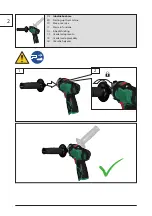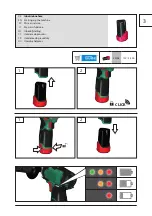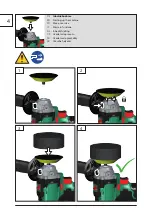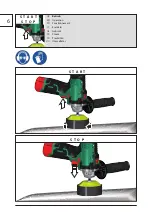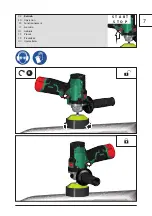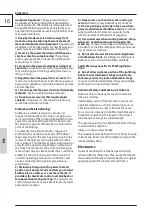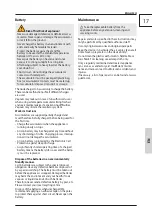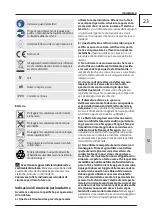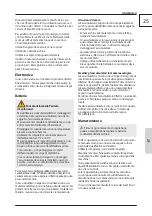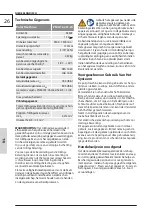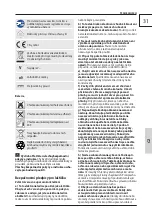
D
16
EN
workpiece fragments.
The eye protection must
be capable of stopping flying debris generated by
various operations. The dust mask or respirator must
be capable of filtrating particles generated by your
operation. Prolonged exposure to high intensity noise
may cause hearing loss.
i) Keep bystanders a safe distance away from
work area. Anyone entering the work area must
wear personal protective equipment.
Fragments of
workpiece or of a broken accessory may fly away and
cause injury beyond immediate area of operation.
j) Never lay the power tool down until the acces-
sory has come to a complete stop.
The spinning
accessory may grab the surface and pull the power
tool out of your control.
k) Do not run the power tool while carrying it at
your side.
Accidental contact with the spinning acces-
sory could snag your clothing, pulling the accessory
into your body.
l) Regularly clean the power tool’s air vents.
The
motor’s fan will draw the dust inside the housing and
excessive accumulation of powdered metal may cause
electrical hazards.
m) Do not operate the power tool near flammable
materials.
Sparks could ignite these materials.
n) Do not use accessories that require liquid
coolants.
Using water or other liquid coolants may
result in electrocution or shock.
Kickback and Related Warnings
Kickback is a sudden reaction to a pinched or
snagged rotating wheel. Pinching or snagging cau-
ses rapid stalling of the rotating wheel which in turn
causes the uncontrolled power tool to be forced in
the direction opposite of the wheel’s rotation at the
point of the binding.
For example, if an abrasive wheel is snagged or
pinched by the workpiece, the edge of the wheel
that is entering into the pinch point can dig into the
surface of the material causing the wheel to climb
out or kick out. The wheel may either jump toward or
away from the operator, depending on direction of
the wheel’s movement at the point of pinching. Ab-
rasive wheels may also break under these conditions.
Kickback is the result of power tool misuse and/or
incorrect operating procedures or conditions and
can be avoided by taking proper precautions as
given below.
a) Maintain a firm grip on the power tool and
position your body and arm to allow you to resist
kickback forces. Always use auxiliary handle, if
provided, for maximum control over kickback or
torque reaction during start-up.
The operator can
control torque reactions or kickback forces, if proper
precautions are taken.
b) Never place your hand near the rotating ac-
cessory.
Accessory may kickback over your hand.
c) Do not position your body in the area where
power tool will move if kickback occurs.
Kickback
will propel the tool in direction opposite to the
wheel’s movement at the point of snagging.
d) Use special care when working corners, sharp
edges etc. Avoid bouncing and snagging the
accessory.
Corners, sharp edges or bouncing have
a tendency to snag the rotating accessory and cause
loss of control or kickback.
e) Do not attach a saw chain woodcarving blade
or toothed saw blade.
Such blades create frequent
kickback and loss of control.toothed saw blade.
Safety Warnings Specific for Polishing Opera-
tions:
a) Do not allow any loose portion of the polishing
bonnet or its attachment strings to spin freely.
Tuck away or trim any loose attachment strings.
Loose and spinning attachment strings can entangle
your fingers or snag on the workpiece.
Additional Safety and Working Instructions
Never reach into the danger area of the machine
when it is running.
Immediately switch off the machine in case of con-
siderable vibrations or if other malfunctions occur.
Check the machine in order to find out the cause.
For accessories intended to be fitted with threaded
hole wheel, ensure that the thread in the wheel is
long enough to accept the spindle length.
The adjusting nut must be tightened before starting
to work with the machine.
Always use the auxiliary handle.
The workpiece must be fixed if it is not heavy enough
to be steady. Never move the workpiece towards the
rotating disk by hand.
Electronics
In case of overload, the rotational speed is being
reduced until machine stops. Please note that the ma-
chine will automatically accelerate back to its original
operating speed if the load is removed from it.
ENGLISCH

